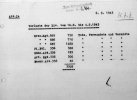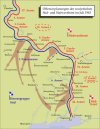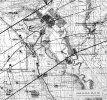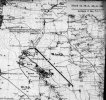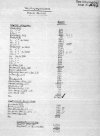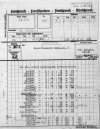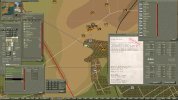Beautiful map. I haven't played the scenario yet (no time atm), but I'll run it when I can free some time.
I know that you marked it as semi-historical scenario, but I saw the AT-Abteilung in the 111th Inf Division with 3 StuG Coys, so I would like to let you know that it would have been an Inf Div's wet dream in that sector (and especially at that time) to have that amount of armored fire power.
I don't know the details of the operation (not my field of interest atm) that cut off the (new / re-established ) 6th Army's XXIX Korps, but XXIX. Korps must have had 5 divisions (including the 13. Panzer-Division) and the main (central) pocket was reduced to 25 square kilometers later on, eventually, while units in the Taganrog sector could still retreat to the west along the coast line and then exit the pocket (partially fighting).The German airfield at Taganrog was one of 6 airfields that had provided air-supply for the encircled 6th Army in Stalingrad, by the way.
Anyway, I hope you don't mind if I post what I know about the operation, so far:
In the XXIX. Korps sector, elements of the 111. Inf Div., on the southern flank of the Russian 5th Shock Army's push and the Korps commanded by Mieth on the northern flank had tried to cut the trail of Russian troops (I think the 4th mech Guards Corps and the 4th Cavalry Corps) that had pushed to the West on 18th of August and the following days and that was then supposed to move south to Natalyevka to encircle XXIX. Korps, but it took Generalmajor Picker's Kampfgruppe (further east), which had only 1 bty of StuG tanks and 2 AT-Coys at its disposal, attacking the trail on its northern flank to create a corridor with a width of 3 kilometers, eventually, which could be held for a couple of days, until the Russian 4th Mech Guards Corps turned to rectify the situation, widening the Russian trail/corridor to a width of 9 kilometers. Initiallially, the 13. Panzer-Division, or what was left of it, was on the Northern flank and assigned to Kampfgruppe Picker and sent into the battle for the German corridor on 23rd of August 1943, but it was pulled out (as it had operated without success) and sent south (through the German corridor) on a forced march to reach and help XXIX Korps, before the corridor would be closed again. After the Russian 4th Mech Guards had rectified the situation and closed the German corridor, it was ordered to pick up the inital plan again and move south with the 4th Cavalry Corps to perform the entrapment of the 6th Army's XXIX. Korps. The task of the Mech. Guards was to protect the Western flank of this push down south, while the Cavalry Corps pushed down to reach Natalyevka.
It seems that the 13. Panzer-Division (so reduced in size that it had the strength of a Panzergrenadier-Regiment and 7 tanks, only) had supported the 111. ID attempting to break through (note: from the inside of the almost closed pocket) and unite with Mieth's Korps north and northwest of the (at the time) pretty large sector that was not a pocket, yet, but both units' efforts were unsuccessful.
The rough positions of XXIX: Korps' units:
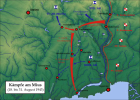
On the 27th of August, the Russians halted, even though the encirclement had not been completed at that point, because they had to get resupplies (mainly ammo, but also fuel and food). The same day, 6th Army hastily ordered XXIX. Korps to strip all its rear-elements and evacuate them to Mariupol, as it was obvious now that XXIX. Korps was threatened to get encircled. The Russian 2nd Guards Army and the 28th Army reduced the Northern part of the pocket, basically by steadily pushing from the horizontal trail down to the middle of the pocket, while other elements in the south pushed west and then north to the middle of the pocket, while the 44th Army performed a curved move, first west, then south, right towards Taganrog, which was reached on 30th of August and captured the next day. Mieth was given the bulk of the 3rd Mountain Division and the bulk of the 17th Panzer-Division to cut off and seal the Russian trail, and he then pushed, attacked several times and reached Kuteinikowo, near the "elbow" of the hook (to the south) performed by the Guards and the Cavalry Corps, on the 30th of August, eventually, but that position was still way west and slightly north of the initial position of the 111. ID elements, so that Mieth's units could not be used to help with the breakthrough.
The 13. Pz.Div, which had elements of the 111. Inf Div in its rear (means slighty northeast of it), had moved south to Jekaterinovka and on 30th of August (I think) all infantry divisions of XXIX. Korps withdrew from their positions. XXIX. Korps' 13. Pz.Div then spearheaded a breakthrough attempt in the western part of the pocket, which was reduced to 25 square kilometers at that point already, with the bulk of XXIX.'s Infantry Divisions behind it or somewhat further south, and pushing as well. On the next day, the breakthrough was accomplished by General Brandenberger's unit (forgot which one he was commanding ;p), but somewhat further south at Konkovo, so that the Korps units could exfiltrate during the night (of the 31st and the 1st of September).
Before the pocket was reduced to that size, 2 escape routes (from Taganrog) were available. Elements of the 117. Artillery Regiment must have been in the Taganrog area for sure, as I have read parts of the 3rd Bn commander's adjutant's letters (to his wife), who committed suicide on the beach of the Sevastopol pocket later on. The following map, which was drawn and put online by a German author who analyzed all of the adjutant's deployments and the letters to reconstruct his personal fate, displays these 2 routes that were used by the elements inside the pocket, after Hitler had allowed to withdraw from the Mius sector to a sector east of Melitopol, where the 111. ID was then ordered to form the 6th Army's Wotan-line at the eastern outskirts of Melitopol, in late September or early October. According to the Adjutants letters, it sounds like his unit (the 3rd Bn of the 117. Artillery-Regiment) retreated along the southern escape route:
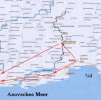
The folks at Lexikon of the Wehrmacht emphasize that the 111. ID's retreated on the route Uspenskaya (which must have been west or northwest of the pocket), Melitopol (where it had to perform some heavy defensive action) and then moved to the bridgehead at Nikopol, before it was inserted on the Crimea by sea, as the Crimea was already cut off at the time.
Other elements of the 111. Inf Division held some heights east of Taganrog until all units of XXIX. Korps were ordered to withdraw and were actually not attacked by the Russian units in front of them. These Russian units were probably elements of rifle divisions and either to weak to attack, or not ordered (or not in the mood ;p to attack) to push, giving the Russian 44th Army's units the opportunity to kill something.
When the battle started, the 336. Inf Div was placed in the north, the 17th Inf Div in the center and the 15. Luftwaffen-Felddivision in the South. Since the 15. Lw-FD was rather weak (it's Recon element was just a bicycle company, and this ID's establishment was interrupted/never completed, because it was rushed into battle in late 1942), I am guessing that it was then decided to have elements of the 111. Inf Div to occupy the heights just east of Taganrog and the town itself. I am also guessing that vital frontline elements (if not the bulk) of the 111. Inf Div was in the northwestern part of the pocket, and not in the Taganrog area.
---
During the 2nd Battle at the Mius described above, the initial Russian main pushes occured just north and south of Kuibyschewo, way north of Tabanrog, just like during the 1st attempt (1st Battle at the Mius, which started on 17th of July), where the Germans managed to re-establish the old main battle line (at the river Mius, with the help of several SS-divisions) around 2nd of August eventually, and where then ALL German units re-occupied their spots at the old main line.
But since the Russians had reinforced their front line units at the Mius with their own (rear-line) troops, as High Command either didn't want to send or couldn't send reinforcements, the 5th Shock Army and the Guards (etc.) could mount another offensive on the 18th of August, already. The war diary of the German 336. Inf Div. explicitly states that captured Russian soldiers reported that all divisional or Coy (supply) columns were combed-out completely, some even to a level where the columns had almost ceased to exist, and where then these troops were incorporated into the frontline units, to replace (some of) the losses. This info and other intelligence pieces made the Germans think that another attack would not be imminent, and it can be assumed that - prior to the offensive - the higher Russian traffic behind the frontline, which was in fact detected during several short-range (aerial) recon runs, was accounted to the Russians shuffling around these rear-line contingents, because motorized or railroad reinforcement from outside the sector could not be spotted and had not occured, indeed. On the 18th of August, the Russian attack then surprised the Germans, indeed, and even more surprising to the Germans, the Russians then pretty much attacked in the same area, where several German units had been pulled out (which weakened these sectors) recently, so that less units were covering the frontline (6th Army had to cover 200 kilometers), now.
----
The following is a scan of the original form reporting the actual ("Ist") and the required ("Soll") strength (troops and weapons) of the 336. Infantry-Division, as of 1st of September 1943 (the day after XXIX. Korps had managed to escape):

The section "gepanzerte Fahrzeuge" (armored vehicles) states that the unit had no tanks, but 14 SPGs ("Pak" means AT and "SF" means SPG) as required number, where the actual number of vehicles amounted to 50% ( or 7) operational ("einsatzbereit") vehicles and some additional 2 vehicles that were in the repair-shop. The target number of 14 AT vehicles surely means that the division's AT Bn was supposed to have an SPG company, usually the 3rd Bn, while the towed AT guns were usually operated by the 1st and the 2nd Bn. In the weapons ("Waffen") section of the form, you can see the required amount of heavy AT guns ("schwere Pak" or "s.Pak", which referred to 75mm AT guns at the time, but 50mm guns were also used), 21 guns, but an actual amount of 2 operational guns, and where even these 2 are marked with an asterix, referring to the SPG ("SF")-section, which makes me think that the AT guns of the 2 vehicles in the repair shop had been removed (before the vehicles were sent to the shop) and put on a wheeled carriage of a knocked out gun, to have at least TWO towed 75mm AT guns, until the repaired SPGs are returned.
The 3rd section in the form allows to enter the missing amount of horses, and that paragraph states that 500 horses are needed to re-establish the full mobility of the unit.
While it's pretty obvious that the unit must have lost quite some of the equipment during the fighting withdrawal (the number could only be guesstimated if the preceding actual/target report would be checked), it's also obvious that the unit must have had way more transportation (horses) and at least some more AT guns, before. But it's also pretty clear, that the unit's AT Bn did not have 3 assault gun Coys (StuG), and I don't even think that such guns were regular parts of their T/O&E, at the time. Some AT Bns' third Bn even had 20mm or 40mm AA guns, instead of AT guns, as the former had proven to be effective tools against unarmored columns and Inf formations, other AT Bns had either a SPG Coy, or (really rare afaik) a Stug Coy.
Basically, AT Bns had 3 Coys, where some of the 3rd Bns comprised of Marder AT SPGs, instead of a third towed heavy AT gun Coy. After the T/O&E change in October 1943, AT Bns were supposed to have six 37mm Pak 35/36, 24 50mm Pak 38 and 18 75mm Pak guns, before a StuG company (as third or first Coy) became common later in the war, Pak 35/36 could only serve as "Army doorknocking devices" (a joke common among soldiers).
Technically, only the 75mm Pak 40 guns could penetrate a KV-1 tank or the T-34's frontal armor, for example, a 50mm Pak 38 had to perform a lucky shot in the rear/side or in the turret ring of a KV-1, in order to penetrate such a beast.
Whatsoever, regarding the AT Bn, the 111. Inf Div's AT Bn might have had a similar layout, where the actual number of AT pieces (vehicles and towed guns) prior to the attack would have to be researched, though. I might check the KStN some time, as I don't think StuGs were regular parts of an AT Bn at the time. Prior to the attack, commanders in that sector stressed that not equipment, but the actual number of available troops was the most serious problem. The 336. Inf Div's actual strength was 9160 troops (incl officers and NCOs), whereas it required strength amounted to 16992 troops.
My guess is, that this unit's AT Bn suffered of a similar understrength situation and of a similar hodgepodge mix of AT weapons, and that there were no StuG guns at hand. I may be wrong, though, like I said, that corner of the Campaign is not my thing.
EDIT: My 22.7 cents
Close enough that I'll have to try again.



